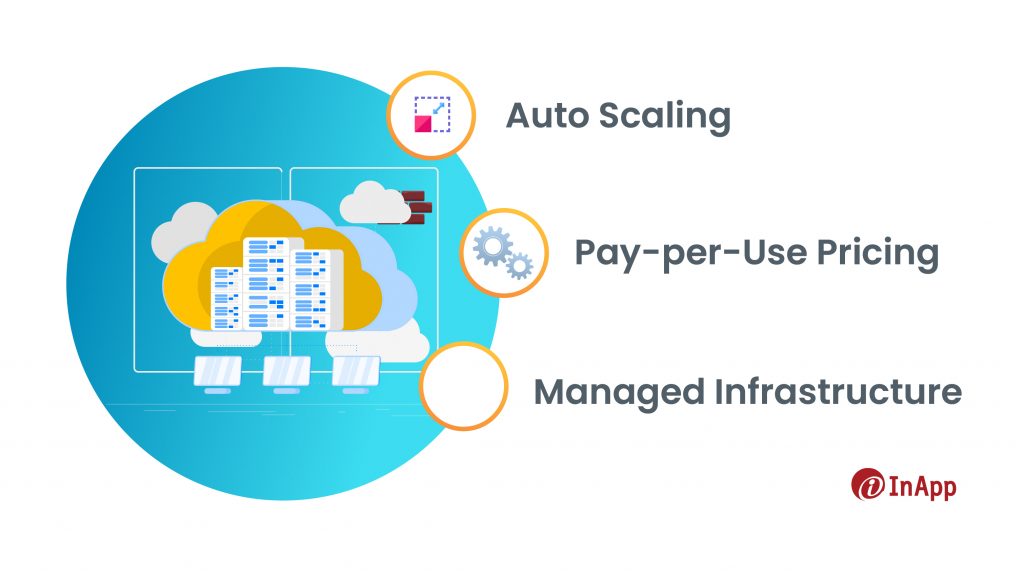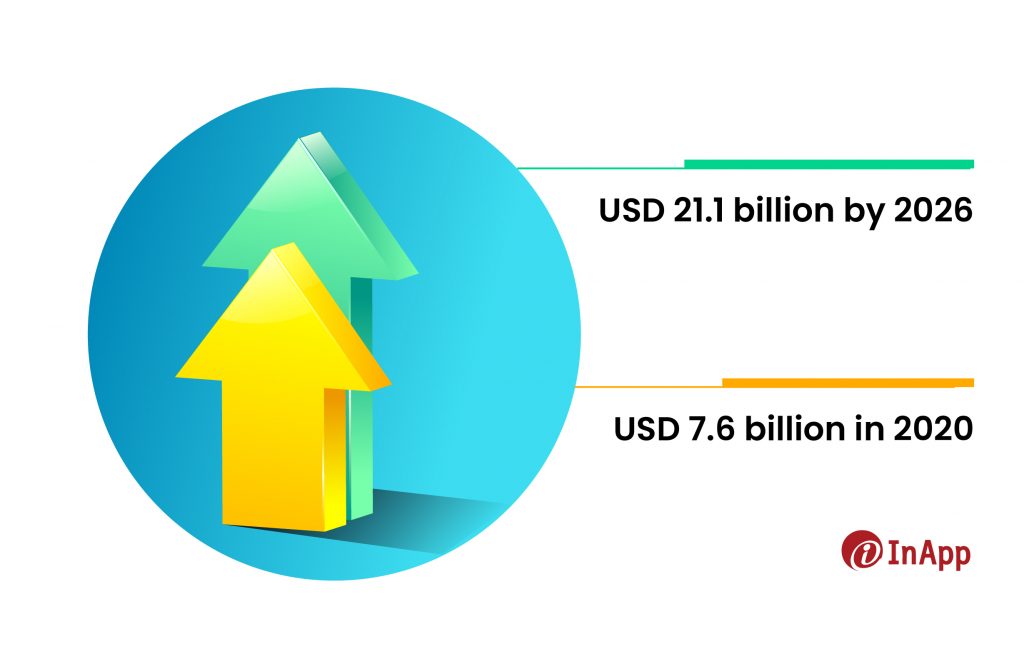In today’s digital era, the adoption of innovative solutions determines the trajectory of an organization’s growth. One exciting development is the projected 26% compound annual growth rate (CAGR) of the serverless architecture market, according to a report published by Global Market Insights.
This report brings forth a compelling opportunity for forward-thinking businesses to leverage the power of serverless architecture and its transformative potential. With its advantages of reduced infrastructure management, enhanced scalability, and improved security, serverless architecture is poised to revolutionize the way businesses operate in the digital landscape.
In this article, we explore the implications of this remarkable growth projection and what it means for your business.
What Is Serverless Architecture?
As the name suggests, serverless architecture is a way to build and run applications without having to manage the infrastructure. Unlike traditional modes (like physical servers and on-premises infrastructure) where business owners must manage and provision servers to run their applications, there is no need for server management in a serverless model.
Compared to traditional methods, the serverless architecture enables businesses to significantly reduce costs and improve efficiency by eliminating the need for server management and provisioning, allowing them to focus on developing applications and responding rapidly to changing demands.
With serverless, you pay only for the actual usage of your code, making it cost-effective. Additionally, it offers automatic scaling, high availability, and reduced operational complexity.
What Are the Different Types of Serverless Architecture?
Several different serverless architectures can be used based on specific use cases and requirements. Common serverless architectural patterns include the following.
1. Function as a Service (FaaS): FaaS is a core serverless architecture where applications are built using individual functions. Each function performs a specific task or handles a specific event. Functions are executed in response to events, and the cloud provider manages the underlying infrastructure and scaling.
2. Backend as a Service (BaaS): BaaS is a serverless architecture that focuses on providing pre-built backend services and APIs. It removes the need to develop and manage backend infrastructure, allowing developers to leverage ready-made services for functionalities such as data storage, authentication, push notifications, and more.
3. Composite Serverless Applications: This architecture combines multiple serverless services and components to create complex, multi-tier applications. Different services, such as serverless functions, databases, storage, and APIs, are integrated to build scalable and modular applications.
How Does a Serverless Architecture Work?
Serverless architecture works by avoiding the underlying infrastructure management and allowing businesses to focus solely on their application code. For the sake of simplicity, let us have a quick look at the Function as a Service (FaaS).
- Application Decomposition: The application is broken down into smaller functions, often referred to as serverless functions or simple functions. Each function performs a specific task or handles a specific event.
- Event Trigger: Functions within a serverless architecture are event-driven, meaning they are triggered by specific events or triggers. These events include HTTP requests, database updates, file uploads, scheduled events, or custom events.
- Function Execution: When an event occurs, the corresponding function is invoked. The serverless platform automatically provisions the necessary resources and runs the function.
Benefits of Serverless Architecture
Serverless architecture offers several benefits that can significantly impact businesses and application development.

- Auto Scaling: Serverless architectures provide automatic scaling and elasticity. The cloud providers will dynamically manage the scaling of functions based on the incoming workload. As the number of incoming events increases, the platform automatically scales up the resources to handle the increased load. Conversely, when the workload decreases, the resources are scaled down to save costs.
- Pay-per-Use Pricing: With serverless architectures, businesses are billed based on the actual usage of functions and resources. They pay for the computational resources consumed during function execution, rather than paying for idle server time. This pay-per-use model allows for cost optimization and efficient resource allocation.
- Managed Infrastructure: The underlying infrastructure required to run the functions is managed by the cloud provider. This infrastructure includes server provisioning, networking, load balancing, and other operational tasks. Businesses are relieved from the burden of managing servers, operating systems, and runtime environments, which allows them to focus on developing and deploying functions.
The Growing Market of Serverless Architecture
The global serverless architecture market has witnessed significant growth, with its size surpassing USD 7.6 billion in 2020. It is projected to experience a robust CAGR of 22.7% and reach USD 21.1 billion by 2026.

One key factor is the increasing demand to shift from CAPEX (capital expenditure) to OPEX (operational expenditure) models, eliminating the need to manage servers and thereby reducing infrastructure costs. Organizations are embracing serverless architecture as it allows them to focus on core business functionalities while eliminating the overhead of server management.
Large enterprises, in particular, are adopting serverless architecture service types at a high rate due to the growing demand for cloud automation. With the need to automate various tasks regularly and manage vast amounts of data, large enterprises invest in advanced technologies to enhance productivity and efficiency. Implementing serverless architecture service types helps them reduce both CAPEX and OPEX, leading to cost savings and improved business operations.
Monitoring and performance management are crucial aspects of maintaining stability and ensuring operational protection in a serverless architecture. However, monitoring becomes more challenging in a serverless context due to the distributed nature of applications. Performance management services enable quick troubleshooting, debugging, and optimization of serverless functions. Monitoring services provide comprehensive visibility across various cloud deployments, offering key network metrics and detecting issues with containers, load balancers, disconnected hosts, and third-party providers.
Serverless architecture provides organizations with the flexibility to scale their applications effortlessly. By leveraging serverless platforms, businesses can automatically scale their resources based on demand, ensuring optimal performance even during peak periods. This agility enables companies to quickly adapt to changing market conditions and handle sudden spikes in user traffic, resulting in improved user experiences and customer satisfaction.
Who Should Use Serverless?
Serverless architecture is suitable for a wide range of use cases and can benefit various types of businesses and developers. Here are some scenarios where serverless can be particularly advantageous.
1. Startups and Small Businesses: Serverless architecture allows startups and small businesses to focus on developing their core products or services without the burden of managing infrastructure. It enables them to rapidly build and deploy applications with reduced upfront costs and scalability as the business grows.
2. Event-Driven Applications: Applications that are event-driven, with unpredictable traffic patterns, can benefit from serverless architecture.
3. Microservices Architecture: Serverless architecture aligns well with microservices-based applications. Each microservice can be implemented as an individual function, enabling independent development, scaling, and deployment. This modular approach allows developers to focus on specific services.
4. DevOps and Agile Development: Serverless architecture aligns with the principles of DevOps and agile development. It enables rapid iteration, continuous integration, and deployment of individual functions. Developers can independently work on functions, test them in isolation, and deploy updates without impacting the entire application.
5. Burstable Workloads and Spikes in Traffic: Applications that experience unpredictable or seasonal bursts in traffic can benefit from serverless architecture. Functions can automatically scale up to handle increased workloads during peak periods, ensuring optimal performance and cost efficiency.
6. Prototyping and MVP Development: Serverless architecture allows for quick prototyping and minimum viable product (MVP) development. Developers can rapidly build and iterate on small, focused functions without the need for extensive infrastructure setup.
7. Cost-Conscious Applications: Businesses seeking cost optimization can benefit from serverless architecture. Pay-per-use pricing ensures that costs align with actual resource consumption, eliminating expenses related to idle resources.
For more information on choosing serverless for web application development, read this article.
Future Trends & Innovations in Serverless Architecture
One prominent trend is the integration of edge computing, which brings computation closer to the source of data generation, reducing latency and enabling real-time processing. That empowers applications to deliver faster and more responsive experiences, making it ideal for emerging technologies like IoT and autonomous systems.
Another key innovation is the integration of machine learning capabilities into serverless functions, enabling the development of intelligent applications that can automate processes, make data-driven decisions, and provide personalized experiences.
Additionally, event-driven architectures are gaining traction, allowing applications to respond dynamically to specific events or triggers, leading to highly scalable and efficient systems. These advancements expand the capabilities and benefits of serverless architecture, enabling businesses to leverage emerging technologies effectively, improve operational efficiency, and deliver exceptional user experiences.
Stay Ahead of The Curve with Serverless Architecture
The projected growth of the serverless architecture market presents significant opportunities for businesses in the evolving technology landscape. With a projected CAGR of 26% from 2023 to 2032, serverless architecture is expected to become increasingly prevalent. This growth is driven by factors such as increased agility, faster time-to-market, and cost optimization.
By leveraging serverless architecture, companies can eliminate the need for managing servers, reduce infrastructure costs, and focus more on core functionalities and innovation. The scalability and flexibility of serverless architecture enable businesses to adapt quickly to changing market conditions and handle peak workloads efficiently.
To stay competitive, organizations should consider the potential implications of serverless architecture and explore how it can benefit their operations. By embracing serverless architecture, businesses can enhance their productivity, deliver faster and more responsive applications, and reduce operational costs. It is essential to evaluate the specific requirements and characteristics of each organization to determine the best approach for implementing serverless architecture effectively.
Looking to migrate to serverless or need answers? Reach out to us for expert assistance and guidance. We’re here to support your journey and ensure a seamless transition. Contact us today!
